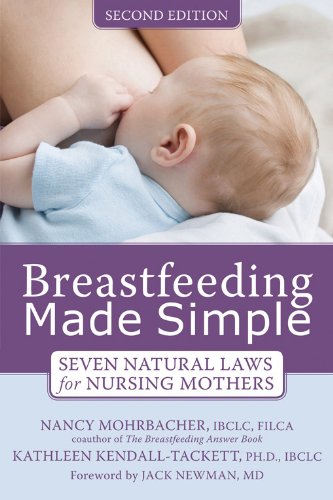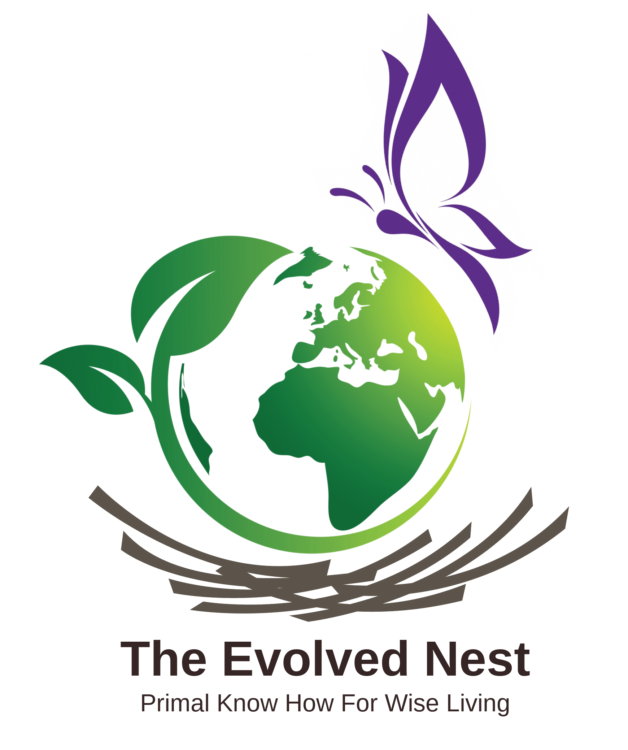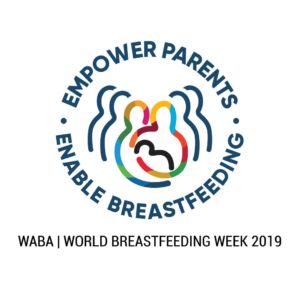Breastfeeding’s Importance—What Science Tells Us, Part 2 of 2
![]() Happy World Breastfeeding Week and National Breastfeeding Month!
Happy World Breastfeeding Week and National Breastfeeding Month!
August 1-7 is World Breastfeeding Week and the entire month of August is breastfeeding month in the United States. Find resources to share on Kindred here.
Breastfeeding’s Importance – What Science Tells Us
PART TWO OF TWO
Misunderstanding of breastfeeding continues while scientific support increases
As noted in the prior post, the late 19th century brought about the development of artificial formula foods for infants, as described in the prior post. Starting in the early 20th century, physicians, then educators (in high school home economics courses), sought to educate mothers into a “scientific motherhood.” Mothers needed to be trained in how to raise a child. Instincts were inadequate to guide mothers in the modern context.
Over time, physicians and mothers changed their views about breastfeeding, which before the 20th century was considered necessary for infant health. There was a shift from a belief in the superiority of breastfeeding to the safety, then superiority of artificial food because artificial formulas could be controlled by outsiders when mothers did not follow physicians’ prescriptions for good living (and most could not or would not). Instead of trusting maternal instinct, assumed to be characteristic of the past, mothers were to be educated by experts with knowledge of science. Physicians, then educators (in high school home economics courses) too, sought to educate mothers into a “scientific motherhood.” Mothers needed to be trained in how to raise a child. Instincts were inadequate to guide mothers in the modern context.
For mothers, this focus on outside advice made sense because the culture emphasized how the science of the day was superior to practices of the past. A scientific motherhood was considered superior to one based on instincts. Mothers lost confidence in their own abilities to (birth and) feed their children.
Perhaps it made sense to think that mothers did not know how to birth or feed their babies in a time of rapid social change and when mothers needed to work—stressful features of 19th-century life. Stress counters the release of oxytocin, which facilitates both birth and breastfeeding. New mothers without the support of the extended family to help them relax and trust their instincts around their baby, were susceptible to disempowerment. Without the wisdom of prior generations in or near the household, their confidence was easily undermined by educated outsiders who told them they knew better. In fact, studies have found that the more contact they have with health workers, the less mothers breastfeed (Montalto, 2008; WHO, 1981).
The undermining of maternal instincts continues. The studies keep pouring in on the benefitis of human breast milk, but you would hardly know it if you look at what Americans seem to believe and society’s lack of support for breastfeeding.
Here is a quick look at some recent research on breastfeeding-related advantages.
 As noted by Wendy Oddy (2017): “Never before in science history has so much been known about the complex significance of breastfeeding for mothers and their children” (p. 27). Power and Schulkin (2016) point out that lactation is an ancient adaptation perhaps 300 million years old. Each species of mammal has its own variety of milk and even each mother has her own variety. They say: “Milk allows mammalian mothers to signal biochemically to their offspring over an extended period, guiding the development of their young” (p. 4). Oddy (2017) notes: “Exclusive breastfeeding for the first 6 months of an infant’s life, with continued breastfeeding for up to 2 years or longer, is recognized as the “gold” standard for infant feeding because human milk is uniquely suited to the human infant, and its nutritional content and bioactivity promote a healthy development…. The composition of human breast milk is complex, containing factors that interact with the infant immune system and intestinal milieu including allergens, cytokines, immunoglobulins, polyunsaturated fatty acids, and chemokines. Transforming growth factor β is a cytokine in human milk involved in maintaining intestinal homeostasis, inflammation regulation, and oral tolerance development.
As noted by Wendy Oddy (2017): “Never before in science history has so much been known about the complex significance of breastfeeding for mothers and their children” (p. 27). Power and Schulkin (2016) point out that lactation is an ancient adaptation perhaps 300 million years old. Each species of mammal has its own variety of milk and even each mother has her own variety. They say: “Milk allows mammalian mothers to signal biochemically to their offspring over an extended period, guiding the development of their young” (p. 4). Oddy (2017) notes: “Exclusive breastfeeding for the first 6 months of an infant’s life, with continued breastfeeding for up to 2 years or longer, is recognized as the “gold” standard for infant feeding because human milk is uniquely suited to the human infant, and its nutritional content and bioactivity promote a healthy development…. The composition of human breast milk is complex, containing factors that interact with the infant immune system and intestinal milieu including allergens, cytokines, immunoglobulins, polyunsaturated fatty acids, and chemokines. Transforming growth factor β is a cytokine in human milk involved in maintaining intestinal homeostasis, inflammation regulation, and oral tolerance development.
We cannot ethically randomly assign babies to receive breast milk or artificial food, but there are studies to cite, as noted by Maureen Minchin in “Evidence streams in infant feeding.”
Immunity
And there are plenty of animal studies showing the benefits of breastmilk to offspring, such as longterm immune function (Darby et al., 2019): “Pre-conception maternal helminth infection transfers via nursing long-lasting cellular immunity against helminths to offspring.”
Keeping preterm babies alive (in this study a mixture of donor milk, which is pasteurized and thereby kills living bacteria, was mixed with mother’s fresh live milk, working best at 10% maternal milk. (See Cacho et al, 2017; Hunt et al., 2011).
Not surprisingly, it seems that pumped breastmilk is not as beneficial as milk suckled at the breast—that it lacks, for example, some of the bacteria found to be important for the gut’s microbiome and doesn’t allow baby’s saliva to signal particular needs to mother’s “scientific laboratory” in her breasts.
Mechanisms
Examining in a review of studies the prevalence of asthma and its relation to artificial feeding, Oddy (2017) noted that formula-fed infants, in comparison to breastfed infants, had a different and less diverse microbiome, which was associated with a greater risk of asthma and eczema
Breastmilk has been linked to a decreased chance of childhood obesity, and a recent study (Yu et al., 2019) suggested one potential mechanism. Humans have several kinds of fat (adipose) tissue. Macrophages are a type of immune cell that guards against infection and in early infant development are able to metabolize milk alkylglycerols, found in human but not cow milk, into an active chemical that in turn drives the macrophage-cytokine-dependent differentiation of beige cells during infancy. Beige and brown fat cells are protective against obesity.
In a prospective cohort study (Belfort et al., 2013) with over 1,200 children to age 7, longer duration of breastfeeding (up to 12 months) was associated with higher scores on IQ tests at age 3 and age 7: “higher Peabody Picture Vocabulary Test score at age 3 years … and with higher intelligence on the Kaufman Brief Intelligence Test at age 7 years.” Because the study was observational, it could not prove a cause-and-effect relationship between breastfeeding and intelligence, though it did control for potential confounding factors such as a mother’s intelligence.
Maternal Health
Breastfeeding may have long-term effects on maternal health. For example, the authors Louis-Jacques & Stuebe (2018) say in the abstract: “Pregnancy is associated with metabolic changes such as increased insulin resistance, hyperlipidemia, and visceral fat accumulation. Persistence of the metabolic changes that occur during pregnancy has been theorized to increase a woman’s lifetime metabolic disease risk. Lactation may play a role in reversing these changes more rapidly.”
What is the appropriate length for breastfeeding a child?
 The American Academy of Pediatrics suggests one year of breastfeeding (assuming American mothers would not do more) and the World Health Organization emphasizes two years of breastfeeding at a minimum. In fact, our species’ normal weaning age seems to be four years, with a longer range noted by anthropologists studying small-band hunter-gatherers around the world (Hewlett & Lamb, 2005). American moms have found their children wanting to breastfeed longer than two years.
The American Academy of Pediatrics suggests one year of breastfeeding (assuming American mothers would not do more) and the World Health Organization emphasizes two years of breastfeeding at a minimum. In fact, our species’ normal weaning age seems to be four years, with a longer range noted by anthropologists studying small-band hunter-gatherers around the world (Hewlett & Lamb, 2005). American moms have found their children wanting to breastfeed longer than two years.
Feeding older children has been documented by Ann Sinnott in her book, Breastfeeding Older Children, and increasingly advocated by bloggers (do a web search!)
Economics of Breastfeeding
The World Bank’s Keith Hansen stated: “If breastfeeding did not already exist, someone who invented it today would deserve a dual Nobel Prize in medicine and economics.”
The cost of not breastfeeding is extensive. Here is a tool to calculate that cost, a tool intended to motivate policymakers and donors to help scale up breastfeeding support systems.
A number of books (see references below) describe how breastfeeding has been undermined by businesses who profit from artificial food making for infants and young children.
More and more people are pointing out (here and here) that formula feeding of babies and toddlers is environmentally costly in comparison to breastfeeding.
Why discuss breastfeeding now?
It is World Breastfeeding Week from August 1-7 and August is National Breastfeeding Month. Importantly, the World Breastfeeding Trends Initiative Global Data Repository ranks the USA 90 out of 97 on breastfeeding benchmarks and progress. This report card, issued every few years, is intended to mobilize action locally. The USA has much to do.
Read Part 1 of this two-part series: Breastfeeding in the USA – A Little History
RESOURCES

Helpful books for Mothers
Biological Nurturing: Instinctual Breastfeeding by Suzanne Colson
The researcher, nurse and midwife, Dr. Suzanne Colson “Biological nurturing is a collective term for mother-baby positions and states that interrelate and interact to release primitive neonatal reflexes and spontaneous maternal breastfeeding behaviors.” (p. 5) It’s a “proactive, mother-led, instinctual breastfeeding approach.” (p. 3)
Breastfeeding Older Children by Ann Sinnott
Helpful books for community activists
Governments Push Infant Formula by George Kent
The Politics of Breastfeeding: When Breasts are Bad for Business by Gabrielle Palmer
Helpful books for researchers
Cassidy, T., & Tom, A.E. (Eds.) (2016). Ethnographies of Breastfeeding: Cultural Contexts and Confrontations. London: Bloomsbury.
Dykes, F. & Moran, V.H. (Eds.) (2009). Infant and Young Child Feeding: Challenges to Implementing a Global Strategy. New York: Wiley-Blackwell.
Stuart-Macadam, P., & Dettwyler, K.A. (Eds. (1995). Breastfeeding: Bioculural Perspectives. New York: Aldine de Gruyter.
Tomori, C., Palmquist, A.E.L., & Quinn, EA (Eds.) (2018). Breastfeeding: New Anthropological Approaches. New York: Routledge.
Power, M.L., & Schulkin, J. Milk: The biology of lactation. Baltimore: Johns Hopkins University Press.
REFERENCES
Belfort MB, Rifas-Shiman SL, Kleinman KP, et al. Infant Feeding and Childhood Cognition at Ages 3 and 7 Years: Effects of Breastfeeding Duration and Exclusivity. JAMA Pediatr. 2013;167(9):836–844. doi:10.1001/jamapediatrics.2013.455
Cacho NT, Harrison NA, Parker LA, Padgett KA, Lemas DJ, Marcial GE, Li N, Carr LE, Neu J, Lorca GL. (2017) Personalization of the Microbiota of Donor Human Milk with Mother’s Own Milk. Front Microbiol. 3;8:1470. doi: 10.3389/fmicb.2017.01470.
Darby et al. (2019). Pre-conception maternal helminth infection transfers via nursing long-lasting cellular immunity against helminths to offspring. Science Advances, Vol. 5, no. 5, eaav3058. doi:10.1126/sciadv.aav30580
Hunt KM, Foster JA, Forney LJ, Schütte UM, Beck DL, Abdo Z, Fox LK, Williams JE, McGuire MK, McGuire MA. (2011) Characterization of the diversity and temporal stability of bacterial communities in human milk. PLoS One 6(6):e21313.
Wolf, J., (2001). Don’t Kill Your Baby: Public health and the decline of breastfeeding in the 19th and 20th centuries. Columbus, OH: The Ohio State University Press.
H. Yu, S. Dilbaz, J. Coßmann, A. C. Hoang, V. Diedrich, A. Herwig, A. Harauma, Y. Hoshi, T. Moriguchi, K. Landgraf, A. Körner, C. Lucas, S. Brodesser, L. Balogh, J. Thuróczy, G. Karemore, M. S. Kuefner, E. A. Park, C. Rapp, J. B. Travers, T. Röszer, Breast milk alkylglycerols sustain beige adipocytes through adipose tissue macrophages. J. Clin. Invest. 130, 2485–2499 (2019). doi:10.1172/JCI125646pmid:31081799
Photo by Shutterstock/SeventyFour


